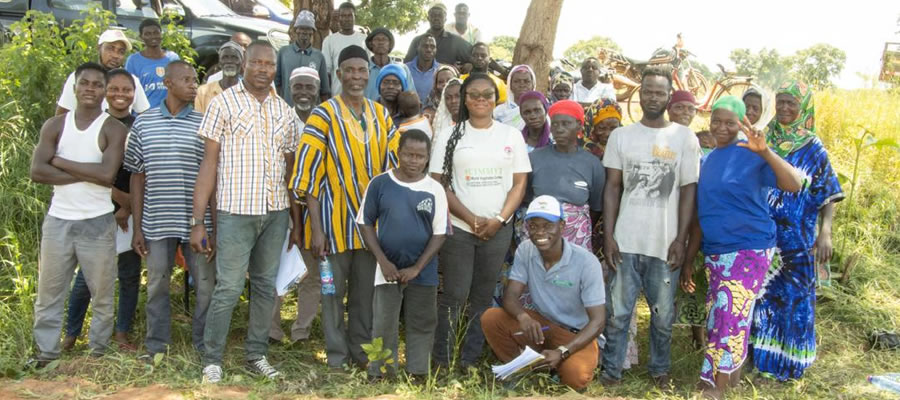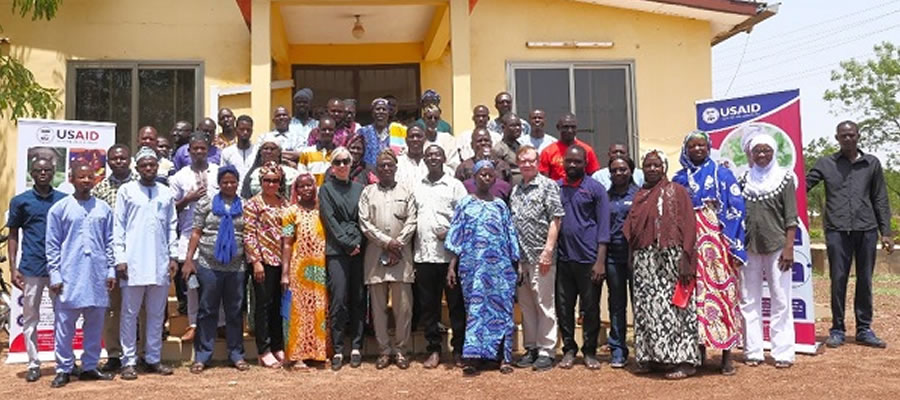

Agriculture: The Municipality is agrarian employing about 74.1% of its labour force. The major crops grown are: maize, rice, yam, groundnut, sorghum, soybean, cow pea, cassava and millet
The estimated land under cultivation and crop yield for the major crops during the medium term period, 2014 – 2017 was as follows:
In 2014, total land under cultivation was 56,250 hectares. This increased by 12.8% to 63,457 in 2015 and fell by 5.3% to 60,104 in 2016. In 2017 the figures increased marginally by 2.1% to 61,337 hectares.
In 2014, total land under cultivation for maize was 9,240 hectares and total yield was 18,480 metric tons. Land under cultivation increased to 10,123, however, maize yield fell drastically to 12,350 in 2015. Area under cultivation reduced marginally to 10,026 and maize yield increased to 13,782 in 2016. Area under cultivation further reduced to 9,820 and maize yield reduced again to 11,784. However, in all the years under review none of the crop yield targets were met.
Rice production in 2014 was 32,571 metric tons and land under cultivation was 9,870. In 2015 land under cultivation increased to 11,351 and production reduced to 29,511. Land under cultivation reduced marginally to 11,256 in 2016 and rice production increased marginally to 30,233. In 2017 land under cultivation reduced to 10,180 and production also reduced to 22,396.
Generally crop yields for all crops were not favourable in 2014 due to the fact that farmers depend on the rains for farming, which was not favourable in 2014 (see table below). The municipality has two rivers at Nabogu and Kukuobila which can be harnessed for irrigation purposes for all year round farming.
Food Security
The sector engages about 74.1 percent of the labour force, of which 80.9% are males and 68% are females. Majority of the farmers produce staple crops at subsistence level. Cash crop production is very minimal and includes sheanut, Soya beans, cotton and cashew.
The Municipality has the potential to increase food crops output if agricultural practices are modernized. However, the sector encounters problems such as food price inflation, high cost of farm inputs, post harvest losses, high cost of inputs, inadequate tractor services and over reliance on rain fed agriculture.
Though Food price fluctuations could emanate from the rain fed agriculture, the absence of storage facilities poses the problem of storage of produce to sell in the lean season. Farmers thus have no alternative than to sell at whatever price after harvest. Food prices are therefore low in the harvest period but high in the lean season. Secondly, tractor services for tilling the land are very significant.
However, apart from a few available tractors, the increasing fuel prices have made tractor services expensive to farmers. Agricultural practices are also dependent on rainfall which is erratic. Thus there is great seasonal unemployment.
The actions that have been adopted are small scale irrigation projects to boost Agriculture. Some irrigation facilities were initiated in the previous plans, but only three have been completed and are being used. These include Bunglung, Kukobila and Libga. Others which are uncompleted schemes are Diplale Small scale Irrigation project, Nyeko, Sogu-Tampia and Chab-chab project. These schemes will be given priority in the current plan.
The Cash crops in Savelugu Municipal include sheanut, Cotton and Cashew. The sheanuts are found in the whole area and they form part of the natural vegetation. In the north, from around Disiga into the Nasia Tributaries Forest Reserve, there is vast natural sheanut vegetation. Tree crop cultivation is also being pursued through ITFC in mango plantation. This is offering employment to the youth. Under the initiative about 541 Acres are currently under Mango production in the Municipality. The plantations range from 1-5 years. However, the gender impact of tree crop cultivation is that the activity is further impoverishing the economic status of women. Shea nut trees from which women gather nuts for butter processing are being fell to transplant mango seedlings. Also, farm holdings on mango plantations are solely male. Farmers are not also satisfied with marketing.
The animals reared in the Municipality are cattle and small ruminants. Cattle produced in 2014 was 35,784 and this increased by 32.6% in 2017. In 2014 sheep production was 40,045 and increased by 24.9% in 2017. Goat production was 43,958 and this increased by 37.5% in 2017.
Generally, animal production was favourable in 2014-2017. The municipality has favourable conditions for animal production.
LIVESTOCK AND POULTRY:
Effective livestock rearing has not really caught up with the population. Despite the presence of the Pong-Tamale Veterinary College in the Municipality, farmers’ interest in involving themselves in activities to provide proper animal health care services have been lukewarm. Animal rearing perhaps is considered a hobby rather than a business. This attitude and the lack of needed infrastructure render the sector a poor source of income for the people. However, almost all farmers keep a few animals/birds such as goats, sheep and fowls. A few have cattle.
Date Created : 11/21/2017 5:34:08 AM










 facebook
facebook
 twitter
twitter
 Youtube
Youtube
 +233 593 831 280
+233 593 831 280 0800 430 430
0800 430 430 GPS: GE-231-4383
GPS: GE-231-4383 info@ghanadistricts.com
info@ghanadistricts.com Box GP1044, Accra, Ghana
Box GP1044, Accra, Ghana